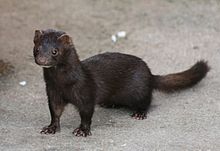
Mink

Mink are dark-colored, semiaquatic, carnivorous mammals of the genera Neovison and Mustela, and part of the family Mustelidae which also includes weasels, otters and ferrets. There are two extant species referred to as 'mink': the American mink and the European mink. The extinct sea mink is related to the American mink, but was much larger. The American mink is larger and more adaptable than the European mink but, due to variations in size, an individual mink usually cannot be determined as European or American with certainty without looking at the skeleton; however, all European mink have a large white patch on their upper lip, whereas only some American mink have this marking: therefore, any mink without the patch is certainly of the American species. Taxonomically, both American and European mink were placed in the same genus Mustela, but most recently, the American mink has been reclassified as belonging to its own genus, Neovison. The American mink's fur has been highly prized for use in clothing, with hunting giving way to farming. Their treatment on fur farms has been a focus of animal rights and animal welfare activism. American mink have established populations in Europe (including Great Britain) and South America, after being released from mink farms by animal rights activists, or otherwise escaping from captivity. In the UK, under the Wildlife & Countryside Act 1981, it is illegal to release mink into the wild. In some countries, any live mink caught in traps must be humanely killed. American mink are believed by some to have contributed to the decline of the less hardy European mink through competition (though not through hybridization—native European mink are in fact more closely related to polecats than to North American mink). Trapping is used to control or eliminate introduced American mink populations. Mink oil is used in some medical products and cosmetics, as well as to treat, preserve and waterproof leather.
